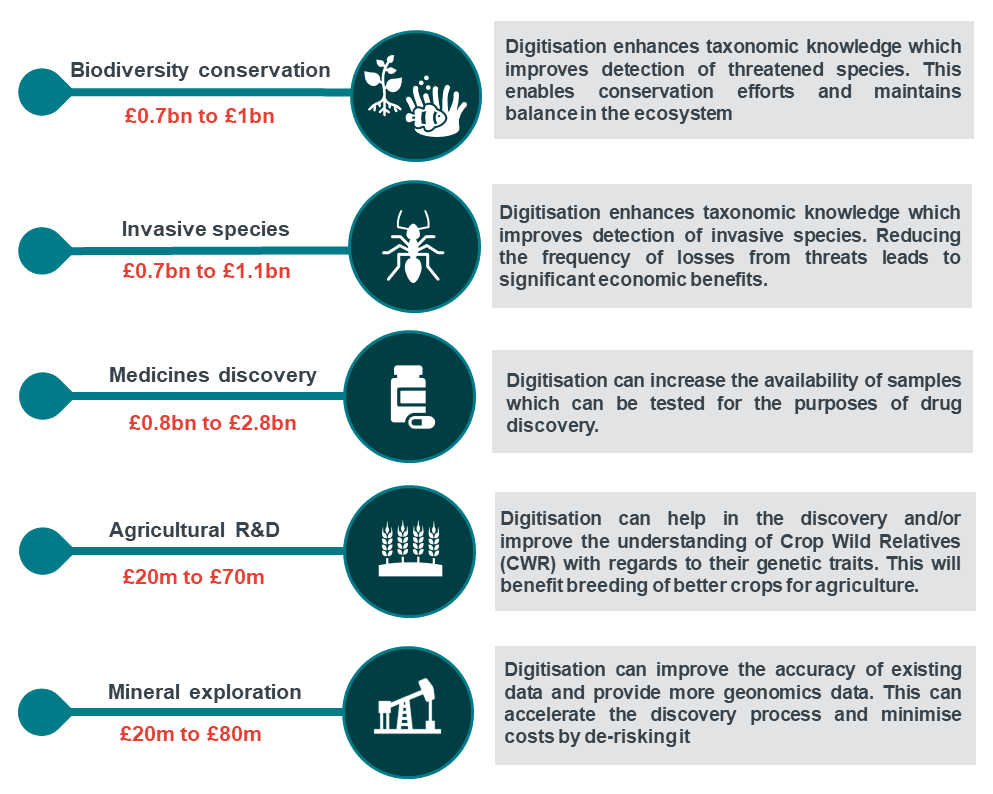
8 December 2021
A recent study from our partners at the National History Museum London confirms that from every one British pound invested in digitising the specimens of a Natural Science Collection, we can expect to receive a return of seven to ten pounds in societal benefits. Beat that, market funds!
From DiSSCo in Europe to iDigBio in the US, ALA in Australia or CRIA in Brazil, digitisation, mobilisation and aggregation of biodiversity data is growing at a fast pace worldwide, enabling a wider community of researchers to have access to vast amounts of biodiversity knowledge and contributing to expand the use of NSCs collections across multiple scientific disciplines.
However, despite the significant growth in digitisation activities during the last 2 decades, there is a fundamental aspect of digitisation that still demands more exploration: its economic impact. Much of the monitoring intended to decipher the actual pay-off of the digitisation effort has typically provided results mostly measurable in terms of digital access metrics (e.g. downloads), article citations or case studies. But is there anything else?
The economic side of things
Just a few months ago, the National History Museum London decided to explore the economic impacts of digitising collections data. The result is a study whose results are encouraging (1).
The study follows three methods: Firstly, exploring five thematic areas -biodiversity conservation; medicines discovery; invasive species; agricultural research & development; and mineral exploitation- with the aim of understanding how massive digitisation of specimens hosted in Natural History Collections can lead to practical, tangible benefits. Secondly, analysing the more recurrent returns on investment in scientific research; and thirdly, scrutinizing the savings that result from having data freely and openly available for all, which could logically open the door to reinvest those savings somewhere else.
Overall, the study confirms that the value of research enabled by digitisation of natural history collections can be in excess of £2 billion over 30 years.

Fig. 1: valuing pathways to impact across five key areas. Part of: Popov D, Roychoudhury P, Hardy H, Livermore L, Norris K (2021) The Value of Digitising Natural History Collections. Research Ideas and Outcomes 7: e78844. https://doi.org/10.3897/rio.7.e78844
More, better and newer research: a pathway to economic value
If you are familiar with DiSSCo, you must know by now that an important part of our Research Infrastructure’s very raison d’être is related to the benefits that digitisation can provide for scientific research. Some of these benefits are mentioned in the study, including wider accessibility to scientific knowledge for a global audience and enriched searchability, that is, easier and more accurate location of relevant content.
“Physical visits are clearly necessary and important, but they are also very time consuming and expensive. Analysis of SYNTHESYS+ project data, shows that the average project for researchers visiting the Museum involves around 10 days of researcher time and costs the researcher more than £3,500. This includes travel costs, which apart from taking a significant portion of the researcher’s overall visit time, also tend to be carbon intensive.” (ibid p. 5)
Translating these benefits and others into immediate economic gain is, in some cases, easy enough. Take accessibility, for example. Remote access to digitised data means saving costs and time. By the same token, accessing a digital twin instead of the actual physical specimen eliminates the potential costs incurred due to damage from handling and transportation. The NHM study goes deeper, however:
“Research has increasingly started to integrate digitised data, which have transformed the production of knowledge by making the process of planning, conducting, disseminating, and assessing research activities more efficient. At the same time, open data have encouraged the sharing and interlinking of heterogenous research data sets, providing efficient ways to model data for new and cross-cutting insights. Researchers are now better able to use data resources from diverse sources which improves the accuracy of scientific findings and helps to identify future directions for research.” (Ibid. p. 16)
Or put in simpler terms: in a landscape of increasingly data-driven research, providing open access to usable digitised data is a key component of innovation across scientific disciplines, which ultimately leads to benefits that can be estimated in economic terms in a number of societal areas (e.g. agriculture, health).
You can access the full article here: https://riojournal.com/article/78844/instance/7573393/
(1) While the methods in this report are relevant to collections globally, this modelling focuses on benefits to the UK, and is intended to support the National History Museum London’s own digitisation work, as well as a current scoping study funded by the Arts & Humanities Research Council about the case for digitising all UK natural science collections as a Research Infrastructure.
Want to know more about DiSSCo and its projects and initiatives? Follow us on Twitter or just visit our News Section regularly!